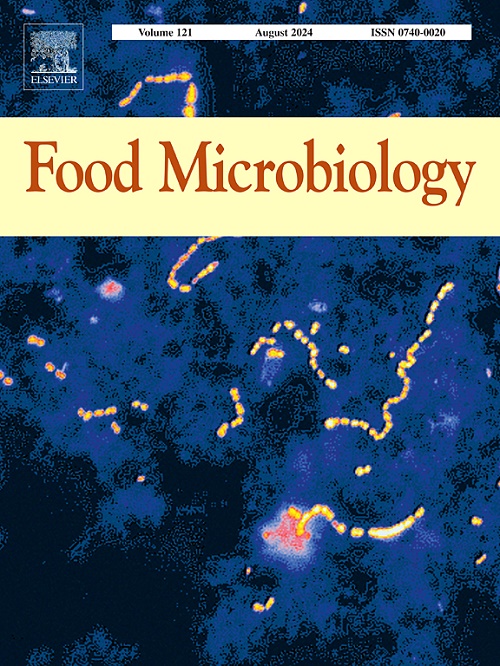Impact of organic acid treatment on the microbial community composition of raw beef during extended refrigerated storage
IF 4.5
1区 农林科学
Q1 BIOTECHNOLOGY & APPLIED MICROBIOLOGY
引用次数: 0
Abstract
Limiting bacterial spoilage and thereby protecting the economic value of raw beef destined for export is a top priority of the United States beef industry. Organic acid processing aids are commonly used to decrease pathogenic loads on raw beef, but knowledge of their efficacy against common spoilage bacteria is limited. Beef chuck rolls (IMPS 116A, N = 24) were obtained from two different processing facilities in Nebraska and treated with either 4.5 % lactic acid, 2.5 % Beefxide®, or 380 ppm peroxyacetic acid alongside a no-treatment control. Samples were stored at 2.7 °C for 112 days. Every 28 days, samples were evaluated using aerobic, anaerobic, psychrotrophic, lactic acid bacteria, and Pseudomonas plate counts and using amplicon sequencing of the V4 region of the 16S rRNA gene. Significant differences (P < 0.05) between groups were determined using DeSeq2. Lactococcus became the most abundant genus on day 28 and every subsequent sampling point regardless of treatment group. Pseudomonas and Yersinia were also present at perceptible levels and were identified to be higher in control samples compared to lactic acid treated samples through differential abundance analysis. Concentrations of culturable bacteria increased during storage across all plating methods (P < 0.05), but treatment differences were minimal. Overall, these treatments had impact on the bacterial diversity during storage. When considering the use of processing aids to limit spoilage, the treatment should be chosen based on a targeted specific spoilage organism.
有机酸处理对生牛肉长期冷藏期间微生物群落组成的影响
限制细菌变质,从而保护出口的生牛肉的经济价值,是美国牛肉行业的首要任务。有机酸加工助剂通常用于减少生牛肉的致病负荷,但对其对常见腐败细菌的功效的了解有限。牛卡盘卷(IMPS 116A, N = 24)从内布拉斯加州的两个不同的加工厂获得,用4.5%乳酸、2.5% Beefxide®或380 ppm过氧乙酸处理,同时进行无处理对照。样品在2.7℃下保存112天。每隔28天,采用好氧菌、厌氧菌、嗜冷菌、乳酸菌和假单胞菌平板计数和16S rRNA基因V4区扩增子测序对样品进行评估。显著差异(P <;0.05),采用DeSeq2测定各组间差异。乳球菌在第28天及之后的每个采样点数量最多。假单胞菌和耶尔森菌也以可察觉的水平存在,并通过差异丰度分析在对照样品中鉴定出与乳酸处理样品相比更高的水平。在所有电镀方法中,可培养细菌的浓度在储存期间增加(P <;0.05),但治疗差异极小。总体而言,这些处理对贮藏期间细菌多样性有影响。当考虑使用加工助剂来限制腐败时,应根据有针对性的特定腐败生物体来选择处理方法。
本文章由计算机程序翻译,如有差异,请以英文原文为准。
求助全文
约1分钟内获得全文
求助全文
来源期刊

Food microbiology
工程技术-生物工程与应用微生物
CiteScore
11.30
自引率
3.80%
发文量
179
审稿时长
44 days
期刊介绍:
Food Microbiology publishes original research articles, short communications, review papers, letters, news items and book reviews dealing with all aspects of the microbiology of foods. The editors aim to publish manuscripts of the highest quality which are both relevant and applicable to the broad field covered by the journal. Studies must be novel, have a clear connection to food microbiology, and be of general interest to the international community of food microbiologists. The editors make every effort to ensure rapid and fair reviews, resulting in timely publication of accepted manuscripts.
 求助内容:
求助内容: 应助结果提醒方式:
应助结果提醒方式:


